词汇学教案
- 格式:doc
- 大小:189.00 KB
- 文档页数:9
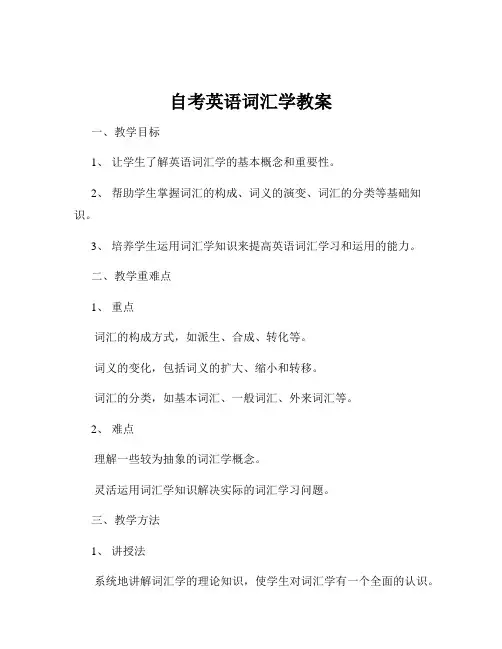
自考英语词汇学教案一、教学目标1、让学生了解英语词汇学的基本概念和重要性。
2、帮助学生掌握词汇的构成、词义的演变、词汇的分类等基础知识。
3、培养学生运用词汇学知识来提高英语词汇学习和运用的能力。
二、教学重难点1、重点词汇的构成方式,如派生、合成、转化等。
词义的变化,包括词义的扩大、缩小和转移。
词汇的分类,如基本词汇、一般词汇、外来词汇等。
2、难点理解一些较为抽象的词汇学概念。
灵活运用词汇学知识解决实际的词汇学习问题。
三、教学方法1、讲授法系统地讲解词汇学的理论知识,使学生对词汇学有一个全面的认识。
2、案例分析法通过实际的词汇例子,帮助学生理解词汇学的概念和规律。
3、练习法布置相关的练习题,让学生巩固所学的知识,提高应用能力。
四、教学过程1、导入(约 10 分钟)同学们,我先给大家讲个事儿。
有一次我去超市买东西,看到一个外国友人在挑选水果,他想要买苹果,但是不知道怎么说,就一直在比划。
旁边的售货员也很着急,不明白他到底想要什么。
最后还是我用英语跟他交流,解决了这个问题。
通过这件事,我就发现啊,掌握足够的英语词汇是多么重要。
而咱们这门英语词汇学,就是要帮助大家更好地理解和掌握英语词汇,让咱们在使用英语的时候更加得心应手。
2、知识讲解(约 40 分钟)(1)词汇学的基本概念解释什么是词汇学,以及它在英语学习中的地位和作用。
举例说明词汇学与日常生活、学习和工作的密切关系。
(2)词汇的构成详细讲解派生、合成、转化这三种主要的构词方式。
比如“unhappy”就是在“happy”前面加上“un”这个前缀构成的,意思就变成了“不开心的”;“classroom”是由“class”和“room”两个单词合成的,就是“教室”的意思;“water”这个词既可以作名词“水”,又可以作动词“浇水”,这就是转化。
(3)词义的演变介绍词义扩大、缩小和转移的概念和例子。
像“bird”这个词,原本指的是“幼鸟”,后来词义扩大,泛指“鸟”;“meat”过去指“食物”,现在词义缩小,只指“肉类”;“coach”最初是“马车”的意思,现在转移为“教练”。
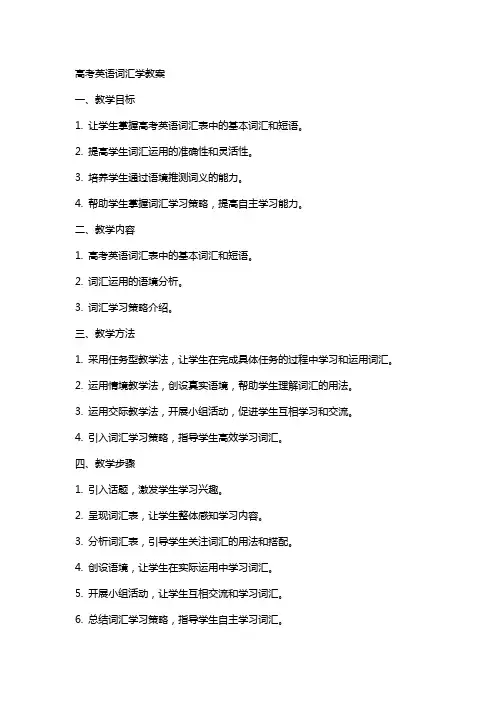
高考英语词汇学教案一、教学目标1. 让学生掌握高考英语词汇表中的基本词汇和短语。
2. 提高学生词汇运用的准确性和灵活性。
3. 培养学生通过语境推测词义的能力。
4. 帮助学生掌握词汇学习策略,提高自主学习能力。
二、教学内容1. 高考英语词汇表中的基本词汇和短语。
2. 词汇运用的语境分析。
3. 词汇学习策略介绍。
三、教学方法1. 采用任务型教学法,让学生在完成具体任务的过程中学习和运用词汇。
2. 运用情境教学法,创设真实语境,帮助学生理解词汇的用法。
3. 运用交际教学法,开展小组活动,促进学生互相学习和交流。
4. 引入词汇学习策略,指导学生高效学习词汇。
四、教学步骤1. 引入话题,激发学生学习兴趣。
2. 呈现词汇表,让学生整体感知学习内容。
3. 分析词汇表,引导学生关注词汇的用法和搭配。
4. 创设语境,让学生在实际运用中学习词汇。
5. 开展小组活动,让学生互相交流和学习词汇。
6. 总结词汇学习策略,指导学生自主学习词汇。
五、课后作业1. 复习本次课所学词汇,整理词汇笔记。
2. 完成课后练习,巩固所学词汇。
3. 选择一个词汇进行深入研究,了解其词源、词性和用法。
4. 制定个人词汇学习计划,每周学习一定数量的高考词汇。
六、教学评价1. 采用形成性评价和终结性评价相结合的方式,关注学生在学习过程中的表现和进步。
2. 通过课堂活动、课后作业和期中期末考试,检查学生对词汇的掌握情况。
3. 鼓励学生自主评价,提高自我认知和反思能力。
七、教学资源1. 高考英语词汇表。
2. 相关词汇学习资料,如词汇书籍、网络资源等。
3. 多媒体教学设备,如投影仪、电脑等。
4. 学习小组合作工具,如讨论区、小组评价表等。
八、教学进度安排1. 第一个月:学习高考英语词汇表中的第一部分词汇。
2. 第二个月:学习高考英语词汇表中的第二部分词汇。
3. 第三个月:复习前两个月所学词汇,进行词汇运用训练。
4. 第四个月:学习高考英语词汇表中的第三部分词汇。
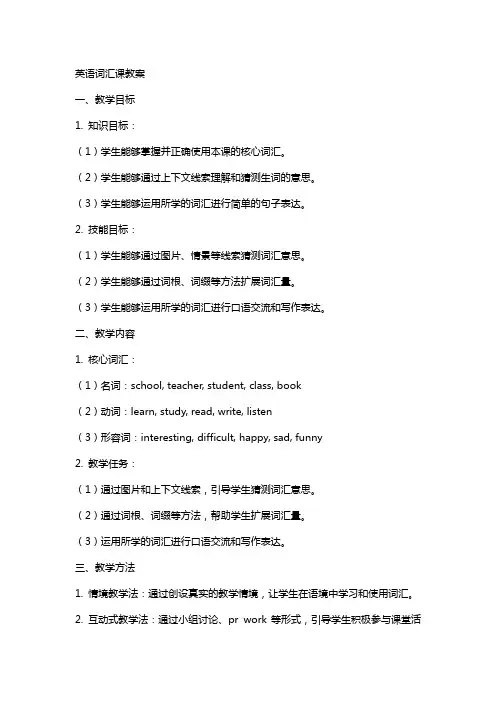
英语词汇课教案一、教学目标1. 知识目标:(1)学生能够掌握并正确使用本课的核心词汇。
(2)学生能够通过上下文线索理解和猜测生词的意思。
(3)学生能够运用所学的词汇进行简单的句子表达。
2. 技能目标:(1)学生能够通过图片、情景等线索猜测词汇意思。
(2)学生能够通过词根、词缀等方法扩展词汇量。
(3)学生能够运用所学的词汇进行口语交流和写作表达。
二、教学内容1. 核心词汇:(1)名词:school, teacher, student, class, book(2)动词:learn, study, read, write, listen(3)形容词:interesting, difficult, happy, sad, funny2. 教学任务:(1)通过图片和上下文线索,引导学生猜测词汇意思。
(2)通过词根、词缀等方法,帮助学生扩展词汇量。
(3)运用所学的词汇进行口语交流和写作表达。
三、教学方法1. 情境教学法:通过创设真实的教学情境,让学生在语境中学习和使用词汇。
2. 互动式教学法:通过小组讨论、pr work等形式,引导学生积极参与课堂活动,提高学生的口语表达能力。
3. 任务型教学法:通过完成具体的任务,让学生在实践中运用所学词汇。
四、教学步骤1. 导入:利用图片和实物,引导学生猜测词汇意思,激发学生的学习兴趣。
2. 呈现:通过上下文线索,呈现核心词汇,引导学生猜测意思。
3. 学习:通过词根、词缀等方法,帮助学生扩展词汇量。
4. 练习:通过口语练习和写作任务,让学生运用所学的词汇。
五、作业设计1. 口语作业:运用所学的词汇进行口语表达,录制短视频或进行角色扮演。
2. 写作作业:以所学的词汇为主题,编写一篇短文,展示对词汇的理解和运用。
3. 复习作业:制作词汇卡片,复习本课学习的词汇,加强记忆。
六、教学评估1. 形成性评估:在教学过程中,通过观察、记录学生的口头表达和写作练习,及时了解学生的学习情况,并根据学生的反馈调整教学策略。
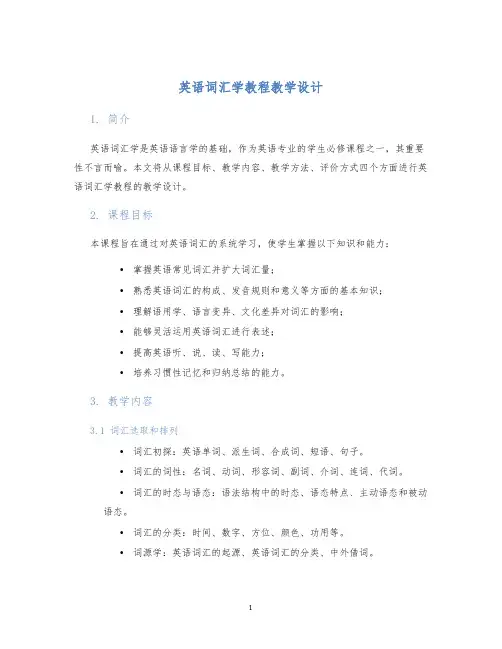
英语词汇学教程教学设计1. 简介英语词汇学是英语语言学的基础,作为英语专业的学生必修课程之一,其重要性不言而喻。
本文将从课程目标、教学内容、教学方法、评价方式四个方面进行英语词汇学教程的教学设计。
2. 课程目标本课程旨在通过对英语词汇的系统学习,使学生掌握以下知识和能力:•掌握英语常见词汇并扩大词汇量;•熟悉英语词汇的构成、发音规则和意义等方面的基本知识;•理解语用学、语言变异、文化差异对词汇的影响;•能够灵活运用英语词汇进行表述;•提高英语听、说、读、写能力;•培养习惯性记忆和归纳总结的能力。
3. 教学内容3.1 词汇选取和排列•词汇初探:英语单词、派生词、合成词、短语、句子。
•词汇的词性:名词、动词、形容词、副词、介词、连词、代词。
•词汇的时态与语态:语法结构中的时态、语态特点、主动语态和被动语态。
•词汇的分类:时间、数字、方位、颜色、功用等。
•词源学:英语词汇的起源、英语词汇的分类、中外借词。
3.2 词汇记忆方法•图像记忆法•关联记忆法•联想记忆法•形近词记忆法•活动记忆法3.3 词汇的语用学与文化差异•词汇的语用学意义:情景语境、抽象词语、隐含意义、语气。
•词汇的文化差异:词汇的文化内涵、习语、比喻、隐喻、因文化而异的词汇。
3.4 词汇的运用和表述•词汇的运用场景:工作、交际、阅读等场合的词汇运用。
•词汇的表述规范:助记法、词汇搭配、语法结构、用词准确。
4. 教学方法4.1 教师授课教师通过讲解、展示、模仿、演示等方式,对课程内容进行阐述和分析,特别是对于语音、语用学、文化差异等方面的知识,教师应进行多角度的讲解,以便学生更好地理解和记忆。
4.2 学生自主学习为了达到词汇量的扩大和词汇运用的能力,学生要通过独立阅读、查找资料、归纳整理等方式来加强能力。
同时,教师也应指导学生如何进行自主学习,如何进行查找资料和利用多种途径和工具加强自己的英语词汇水平。
4.3 互动交流教师应加强与学生的联系和交流互动,通过小组合作、课堂讨论、互相分享等方式,增强学生词汇的活跃度和沉淀度。
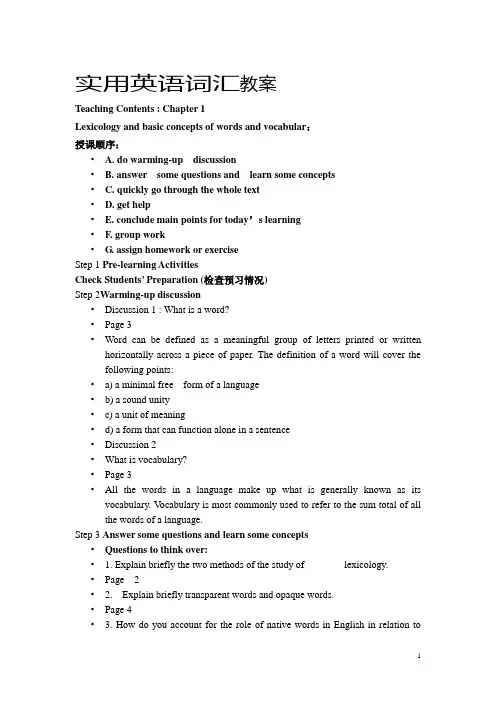
实用英语词汇教案Teaching Contents : Chapter 1Lexicology and basic concepts of words and vocabular:授课顺序:• A. do warming-up discussion• B. answer some questions and learn some concepts• C. quickly go through the whole text• D. get help• E. conclude main points for today’s learning• F. group work•G. assign homework or exerciseStep 1 Pre-learning ActivitiesCheck Students’ Preparation (检查预习情况)Step 2Warming-up discussion•Discussion 1 : What is a word?•Page 3•Word can be defined as a meaningful group of letters printed or written horizontally across a piece of paper. The definition of a word will cover the following points:•a) a minimal free form of a language•b) a sound unity•c) a unit of meaning•d) a form that can function alone in a sentence•Discussion 2•What is vocabulary?•Page 3•All the words in a language make up what is generally known as its vocabulary. V ocabulary is most commonly used to refer to the sum total of all the words of a language.Step 3 Answer some questions and learn some concepts•Questions to think over:• 1. Explain briefly the two methods of the study of lexicology.•Page 2• 2. Explain briefly transparent words and opaque words.•Page 4• 3. How do you account for the role of native words in English in relation toloan-words?•page 4 and page 133•Questions to think over:• 4. What are the classifications of words?(如何分类单词)•Page 3-4•1) full words and form words•2) popular word and learned word•3) abstract word and concrete word•4) transparent word and opaque words•5) polysemic word and monosemic word•6) native word and loan word•Concepts to learn:•Lexicology Page 1•Lexicology, as the science of words, is a branch of linguistics, inquiring into the origins and meanings of words. English lexicology aims at investigating and studying the morphological structures of English words and word equivalents, their semantic structures, relations, historical development, formation, and usages.• 2. word•(We learned just now!)• 3. vocabulary•(We also learned just now!)Step 4 Go through the whole text• 1.1 The definition of lexicology• 1.1.1 The domains of English lexicology•First…Secondly…•Thirdly…Lastly…• 1.1.2 Methods of study of lexicology• 1.2 The definition of word• 1.3 The definition of vocabulary• 1.4 Classification of wordsStep 5Helping time for solving problems.Put up your hand and let me know if you still don’t understand the text. I will come to help !!Step 6 Conclude main points for today’s learning•Main points for today• 1. the definition of English lexicology•Page 1• 2. the domains of English lexicology•Page 1• 3. methods of study of lexicology•Page 2• 4. the definition of word•Page 35. the definition of vocabulary•Page 3• 6. Classification of words•Page 3---4Step 7Group work•Discussing, writing and speaking :•Work in groups of threes or fours and think over and write on the topic Why Should a Chinese Student of English Study English Lexicology? When the group is ready, please choose one student to represent the group to make a presentation in front of the class.(先进行小组讨论,然后选一位代表来到台前陈述小组的想法和讨论结果。
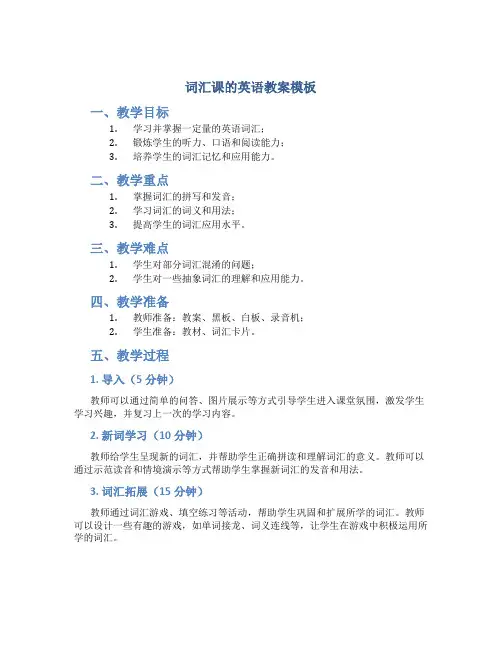
词汇课的英语教案模板一、教学目标1.学习并掌握一定量的英语词汇;2.锻炼学生的听力、口语和阅读能力;3.培养学生的词汇记忆和应用能力。
二、教学重点1.掌握词汇的拼写和发音;2.学习词汇的词义和用法;3.提高学生的词汇应用水平。
三、教学难点1.学生对部分词汇混淆的问题;2.学生对一些抽象词汇的理解和应用能力。
四、教学准备1.教师准备:教案、黑板、白板、录音机;2.学生准备:教材、词汇卡片。
五、教学过程1. 导入(5分钟)教师可以通过简单的问答、图片展示等方式引导学生进入课堂氛围,激发学生学习兴趣,并复习上一次的学习内容。
2. 新词学习(10分钟)教师给学生呈现新的词汇,并帮助学生正确拼读和理解词汇的意义。
教师可以通过示范读音和情境演示等方式帮助学生掌握新词汇的发音和用法。
3. 词汇拓展(15分钟)教师通过词汇游戏、填空练习等活动,帮助学生巩固和扩展所学的词汇。
教师可以设计一些有趣的游戏,如单词接龙、词义连线等,让学生在游戏中积极运用所学的词汇。
4. 听力训练(15分钟)教师播放一段与词汇相关的录音,然后提问学生相关内容,训练学生的听力理解和应对能力。
教师可以根据学生的水平选择合适的录音内容,如听对话选出正确答案、听短文回答问题等。
5. 课堂练习(15分钟)教师布置一些课堂练习,让学生进行词汇的复习和运用。
教师可以要求学生完成填空、翻译等练习,以巩固和应用所学的词汇。
6. 课堂总结(5分钟)教师对本节课的内容进行总结,强调重点和难点,激发学生对英语学习的兴趣,并对学生的表现给予肯定和鼓励。
六、作业布置教师根据学生的学习情况,布置合适的作业巩固和拓展词汇。
作业可以包括词汇练习题、阅读理解等,以提高学生的词汇记忆和应用能力。
七、课后反思教师对本节课的教学效果进行反思,回顾教学中的不足和不足之处,并调整教学策略和方法,为下一节课做好准备。
以上是一份词汇课的英语教案模板,可以根据实际教学需要进行调整和补充。
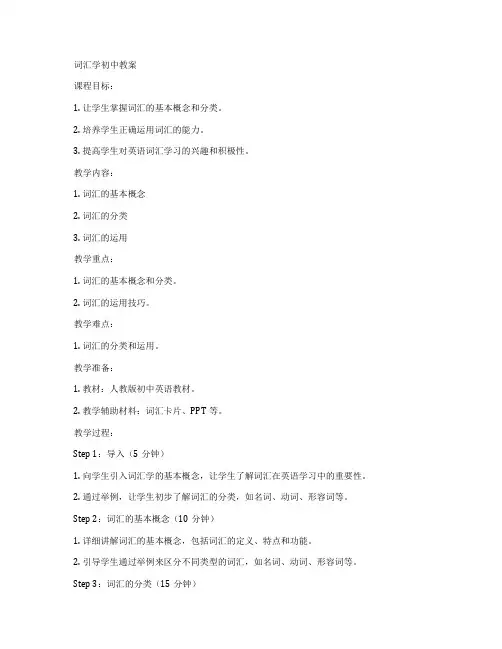
词汇学初中教案课程目标:1. 让学生掌握词汇的基本概念和分类。
2. 培养学生正确运用词汇的能力。
3. 提高学生对英语词汇学习的兴趣和积极性。
教学内容:1. 词汇的基本概念2. 词汇的分类3. 词汇的运用教学重点:1. 词汇的基本概念和分类。
2. 词汇的运用技巧。
教学难点:1. 词汇的分类和运用。
教学准备:1. 教材:人教版初中英语教材。
2. 教学辅助材料:词汇卡片、PPT等。
教学过程:Step 1:导入(5分钟)1. 向学生引入词汇学的基本概念,让学生了解词汇在英语学习中的重要性。
2. 通过举例,让学生初步了解词汇的分类,如名词、动词、形容词等。
Step 2:词汇的基本概念(10分钟)1. 详细讲解词汇的基本概念,包括词汇的定义、特点和功能。
2. 引导学生通过举例来区分不同类型的词汇,如名词、动词、形容词等。
Step 3:词汇的分类(15分钟)1. 讲解词汇的分类,包括名词、动词、形容词、副词、介词等。
2. 通过PPT或词汇卡片,展示各类词汇的例词,让学生进行分类练习。
Step 4:词汇的运用(10分钟)1. 讲解词汇的运用技巧,如词汇的搭配、用法和词性转换等。
2. 引导学生通过造句或填空练习,运用所学词汇。
Step 5:课堂小结(5分钟)1. 让学生总结本节课所学的内容,巩固知识点。
2. 鼓励学生积极提问,解答学生的疑问。
Step 6:课后作业(课后自主完成)1. 让学生完成课后作业,巩固本节课所学内容。
2. 鼓励学生自主查阅词典,了解更多词汇知识。
教学反思:本节课通过讲解词汇的基本概念、分类和运用,使学生了解了词汇在英语学习中的重要性。
在教学过程中,要注意引导学生通过举例和实践来掌握词汇的分类和运用,提高学生的英语表达能力。
同时,要关注学生的学习反馈,及时调整教学方法和节奏,确保学生能够有效吸收和巩固所学知识。
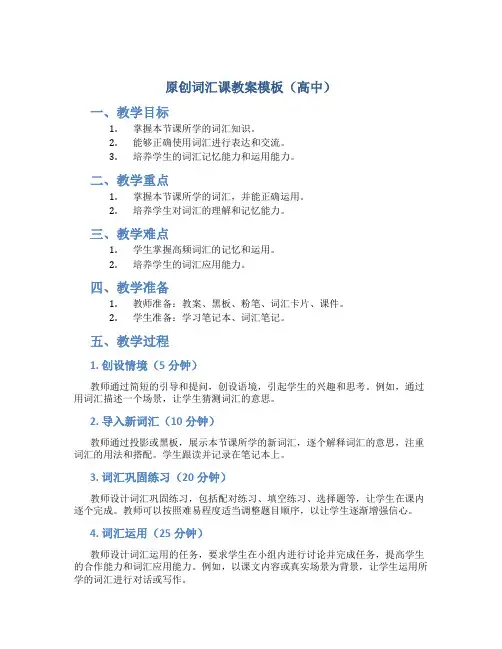
原创词汇课教案模板(高中)一、教学目标1.掌握本节课所学的词汇知识。
2.能够正确使用词汇进行表达和交流。
3.培养学生的词汇记忆能力和运用能力。
二、教学重点1.掌握本节课所学的词汇,并能正确运用。
2.培养学生对词汇的理解和记忆能力。
三、教学难点1.学生掌握高频词汇的记忆和运用。
2.培养学生的词汇应用能力。
四、教学准备1.教师准备:教案、黑板、粉笔、词汇卡片、课件。
2.学生准备:学习笔记本、词汇笔记。
五、教学过程1. 创设情境(5分钟)教师通过简短的引导和提问,创设语境,引起学生的兴趣和思考。
例如,通过用词汇描述一个场景,让学生猜测词汇的意思。
2. 导入新词汇(10分钟)教师通过投影或黑板,展示本节课所学的新词汇,逐个解释词汇的意思,注重词汇的用法和搭配。
学生跟读并记录在笔记本上。
3. 词汇巩固练习(20分钟)教师设计词汇巩固练习,包括配对练习、填空练习、选择题等,让学生在课内逐个完成。
教师可以按照难易程度适当调整题目顺序,以让学生逐渐增强信心。
4. 词汇运用(25分钟)教师设计词汇运用的任务,要求学生在小组内进行讨论并完成任务,提高学生的合作能力和词汇应用能力。
例如,以课文内容或真实场景为背景,让学生运用所学的词汇进行对话或写作。
5. 总结归纳(10分钟)教师引导学生回顾本节课所学的词汇,并总结归纳词汇的用法和搭配。
教师可以提供一些补充的例句和相关知识点,帮助学生更好地理解和记忆词汇。
6. 课堂小结(5分钟)教师对本节课的内容进行小结,并鼓励学生在日常学习中多加复习和应用所学的词汇知识。
六、学生作业布置课后作业,要求学生复习本节课所学的词汇,并运用到实际生活中。
可以要求学生写一篇关于词汇应用的短文,或设计一组有关词汇的问答题目。
七、板书设计黑板上可以简洁明了地写下本节课所学的词汇和相关例句,以及一些重点知识点。
八、教学反思本节课设计了多种形式的词汇练习和运用任务,能够激发学生的学习兴趣,增强学生的词汇运用能力。
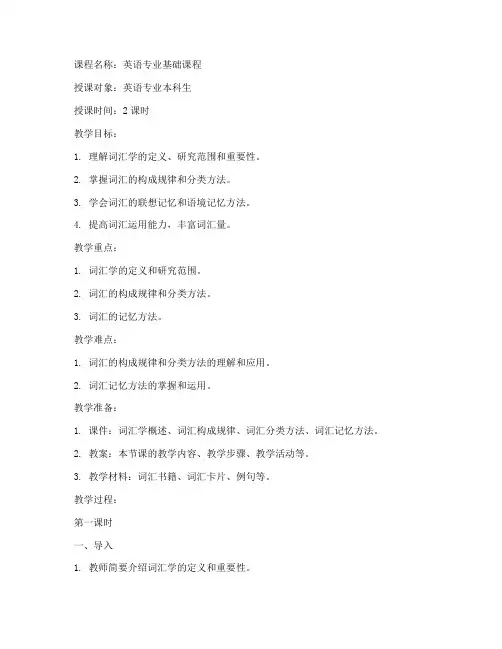
课程名称:英语专业基础课程授课对象:英语专业本科生授课时间:2课时教学目标:1. 理解词汇学的定义、研究范围和重要性。
2. 掌握词汇的构成规律和分类方法。
3. 学会词汇的联想记忆和语境记忆方法。
4. 提高词汇运用能力,丰富词汇量。
教学重点:1. 词汇学的定义和研究范围。
2. 词汇的构成规律和分类方法。
3. 词汇的记忆方法。
教学难点:1. 词汇的构成规律和分类方法的理解和应用。
2. 词汇记忆方法的掌握和运用。
教学准备:1. 课件:词汇学概述、词汇构成规律、词汇分类方法、词汇记忆方法。
2. 教案:本节课的教学内容、教学步骤、教学活动等。
3. 教学材料:词汇书籍、词汇卡片、例句等。
教学过程:第一课时一、导入1. 教师简要介绍词汇学的定义和重要性。
2. 学生分享自己学习词汇的经验和困惑。
二、词汇学概述1. 介绍词汇学的定义和研究范围。
2. 分析词汇学的研究意义。
三、词汇的构成规律1. 介绍词汇的构成规律,如词根、词缀、词性等。
2. 通过实例讲解词汇的构成规律。
四、词汇分类方法1. 介绍词汇的分类方法,如根据词性、词义、构词法等。
2. 通过实例讲解词汇的分类方法。
五、词汇记忆方法1. 介绍词汇的联想记忆方法。
2. 介绍词汇的语境记忆方法。
六、课堂练习1. 学生根据所学内容,完成词汇分类练习。
2. 学生运用词汇记忆方法,记忆新词汇。
第二课时一、复习1. 教师提问,检查学生对词汇学知识的掌握情况。
2. 学生分享自己的学习心得。
二、词汇记忆方法实践1. 教师引导学生运用联想记忆方法,记忆新词汇。
2. 教师引导学生运用语境记忆方法,记忆新词汇。
三、词汇运用练习1. 学生根据所学内容,完成词汇运用练习。
2. 教师点评学生的练习,指出不足之处。
四、总结1. 教师总结本节课所学内容,强调词汇学的重要性。
2. 学生分享自己的学习收获。
教学反思:1. 本节课通过讲解、实例分析、课堂练习等多种教学方法,帮助学生掌握了词汇学的相关知识。
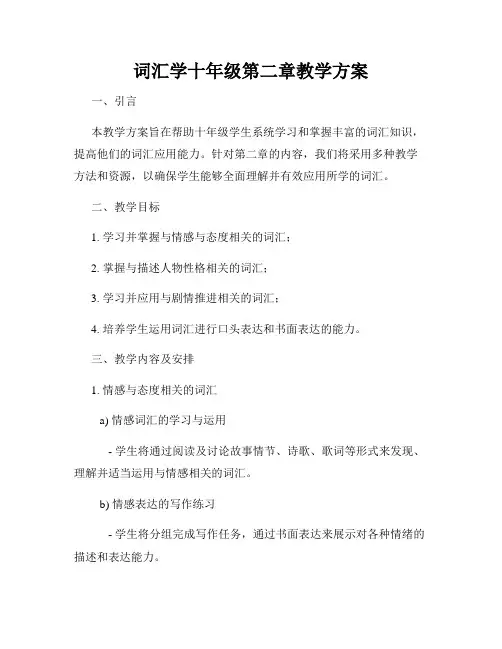
词汇学十年级第二章教学方案一、引言本教学方案旨在帮助十年级学生系统学习和掌握丰富的词汇知识,提高他们的词汇应用能力。
针对第二章的内容,我们将采用多种教学方法和资源,以确保学生能够全面理解并有效应用所学的词汇。
二、教学目标1. 学习并掌握与情感与态度相关的词汇;2. 掌握与描述人物性格相关的词汇;3. 学习并应用与剧情推进相关的词汇;4. 培养学生运用词汇进行口头表达和书面表达的能力。
三、教学内容及安排1. 情感与态度相关的词汇a) 情感词汇的学习与运用- 学生将通过阅读及讨论故事情节、诗歌、歌词等形式来发现、理解并适当运用与情感相关的词汇。
b) 情感表达的写作练习- 学生将分组完成写作任务,通过书面表达来展示对各种情绪的描述和表达能力。
2. 描述人物性格相关的词汇a) 描述性格的常用词汇学习- 学生将通过观察和分析小说、电影、演讲等材料,学习并理解描述人物性格的常用词汇。
b) 口头描述练习- 学生将在小组内进行角色扮演,通过口头描述来展示对人物性格词汇的运用能力。
3. 剧情推进相关的词汇a) 掌握剧情推进所需的词汇- 学生将学习与剧情推进相关的词汇,如时间词、转折词、逻辑连接词等。
b) 阅读理解和写作练习- 学生将通过阅读故事情节和完成写作任务,锻炼对剧情推进词汇的理解和运用。
4. 口头和书面表达能力训练a) 观看相关演讲和讲解视频- 学生将通过观看演讲和讲解视频,培养自己的口头表达能力,并学习有效引用词汇的方法。
b) 书面表达训练- 学生将完成一系列书面作业,如写作、翻译等,来提高自己的书面表达能力。
四、教学资源1. 课本和词汇手册2. 图书馆借阅的小说和故事书3. 视频资源:教学讲解、相关演讲和讲解视频五、教学评估1. 口头表达评估- 学生将进行小组或全班演讲,展示对所学词汇的运用能力。
2. 书面表达评估- 学生将完成指定的写作或翻译任务,并由老师进行评分。
3. 课堂参与度评估- 学生在课堂上的活跃度、互动和合作也将纳入评估范畴。
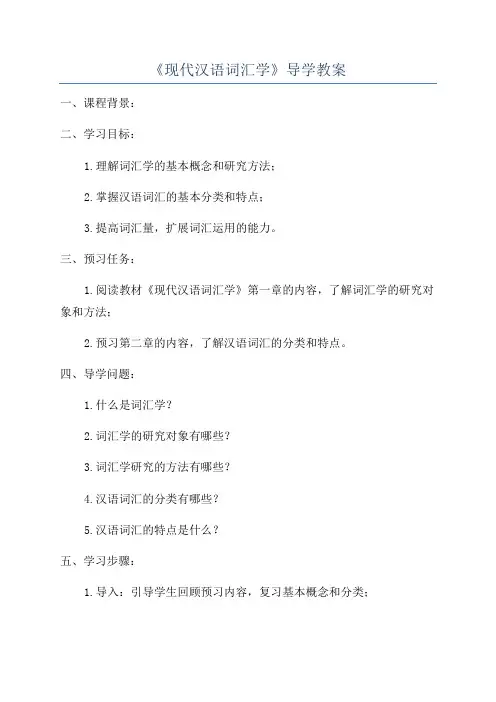
《现代汉语词汇学》导学教案
一、课程背景:
二、学习目标:
1.理解词汇学的基本概念和研究方法;
2.掌握汉语词汇的基本分类和特点;
3.提高词汇量,扩展词汇运用的能力。
三、预习任务:
1.阅读教材《现代汉语词汇学》第一章的内容,了解词汇学的研究对象和方法;
2.预习第二章的内容,了解汉语词汇的分类和特点。
四、导学问题:
1.什么是词汇学?
2.词汇学的研究对象有哪些?
3.词汇学研究的方法有哪些?
4.汉语词汇的分类有哪些?
5.汉语词汇的特点是什么?
五、学习步骤:
1.导入:引导学生回顾预习内容,复习基本概念和分类;
2.分组讨论:将学生分成小组,让每个小组选择一个问题进行讨论并展示讨论结果;
3.全班讨论:收集各小组的讨论结果,进行全班讨论,澄清问题和巩固知识;
4.拓展学习:教师给学生提供更多相关的资料和例子,引导学生进一步深入学习;
5.练习巩固:布置相关的练习题,让学生运用所学知识进行练习和巩固。
六、作业:
1.选择一篇文章,对其中出现的词汇进行分类,并写出相应的特点;
2.分析一篇新闻报道中的词汇使用情况,写出你的观察和观点。
七、教学评价:
通过学生的讨论和练习,教师可以评价学生对于词汇学基本概念和分类的理解和掌握程度,并针对学生的错误和困惑进行指导和反馈,以便进一步提高学生的词汇学水平。
《词汇学》教案英语词汇学课程Chapter I The basic concepts of words and vocabulary1.1 What is a word?A word is a minimal free form of a language that has a given sound, meaning and syntactic function. 词是具有一定的声音、意义和语法功能,能独立运用的最小的语言单位。
1.2 What is vocabulary?The total number of the words in a language.All the words used in a particular historical period.All the words of a given dialect, a given book, a given discipline and the words possessed by an individual person.1.3 Sound and meaningWhat’s the relationship between s ound and meaning? Arbitrary, Conventional1.4 Sound and formWhat causes the differences between sound and form?More morphemes than letters,Stabilization of spelling,Deliberate change of spelling by early, scribes for easier recognition,Borrowing of foreign words.1.5 Classification of wordsCriterion: by use frequency:Basic word stock,Non-basic vocabularyCriterion: by notion:Content words,Functional wordsCriterion: by origin:Native words,Borrowed words1. Basic word stock and non-basic vocabulary基本词汇和非基本词汇Five basic features of the basic word stockAll national character 全民性, Stability 稳定性, Productivity 能产性, Polysemy 多义性, Collocability 搭配能力强Non-basic vocabularyTerminology 专业术语, Jargon 行话, Slang 俚语, Argot 隐语, Dialectal words 方言词, Archaisms 古语词, Neologisms 新词语2. Content words and functional words 实义词和功能词Content words/Notional words/Lexical wordsConstitute the main body of the English vocabulary, numerous and the number is ever growingFunctional words/Empty/form words/Grammatical wordsConstitute a very small number of the vocabulary; stable3. Native words and borrowed words 本族语词和外来语词Native words / Angle-Saxon wordsThe features of native wordsBorrowed words/ loan words / borrowingsDenizens同化词Aliens 非同化词Translation-loans 译借词Semantic loans 语义借词Denizens are words borrowed early in the past and now are well assimilated into the English language. 同化词指早期借入, 其拼写和读音完全符合本族语词规范的借词。
原创词汇课教案模板高中一、教学目标本节课的教学目标主要包括:1.学习并掌握一定量的高中英语词汇;2.提高学生的词汇记忆和运用能力;3.培养学生的词汇拓展意识和实际运用能力。
二、教学内容本节课的教学内容为高中英语词汇。
三、教学重点和难点1. 教学重点•学习和记忆高中英语必备词汇;•培养学生灵活运用词汇的能力。
2. 教学难点•如何让学生记忆高效地掌握大量词汇;•如何让学生能够在实际运用中灵活运用所学词汇。
四、教学准备•教师准备好词汇教材和相关教学资料;•教师准备好多媒体设备以支持教学。
五、教学过程1. 导入(5分钟)通过提问或展示图片等方式引起学生对词汇的兴趣,并导入本节课的主题。
2. 学习词汇(25分钟)利用多媒体设备,以短语、例句、图片等形式呈现词汇,帮助学生理解和记忆词汇的意思和用法。
3. 拓展运用(20分钟)让学生通过各种形式的练习,如填空、造句、讨论等,进行词汇的拓展运用,以提高学生的词汇应用能力。
4. 小结与评价(5分钟)教师对本节课所学内容进行小结,并对学生的学习表现进行评价和指导。
六、教学延伸教师可以要求学生通过阅读、写作等方式进一步巩固所学词汇,并在下节课进行相关的检测和复习。
七、教学反思本节课的教学内容主要是围绕词汇的学习展开,通过多种教学手段让学生掌握并记忆所学词汇。
同时通过拓展运用的环节,培养学生的灵活运用词汇的能力。
整个教学过程设计紧凑,内容丰富,可以有效地提高学生的词汇水平和运用能力。
然而,需要注意的是在教学过程中要根据学生的实际情况和学习能力合理安排教学进度,确保教学进程和学习效果的平衡。
同时,还要注重培养学生的词汇拓展意识,引导他们自主学习和积累更多的词汇知识。
总之,通过有效的教学设计和灵活的教学方法,可以提高学生的词汇水平,使他们能够更好地应对英语学习和实际应用中的词汇问题。
#### 教学目标1. 知识与技能:- 学生能够掌握词汇学的基本概念和分类。
- 学生能够识别和区分同义词、反义词、近义词等。
- 学生能够运用词汇学知识解释词义的变化和词性的转换。
2. 过程与方法:- 通过案例分析,培养学生观察、分析和归纳的能力。
- 通过小组讨论,提高学生的合作意识和表达能力。
3. 情感态度与价值观:- 培养学生对词汇学习的兴趣和积极性。
- 增强学生对语言多样性和文化差异的认识。
#### 教学重点与难点- 重点:词汇学基本概念的理解和应用。
- 难点:词义变化和词性转换的识别与解释。
#### 教学准备- 教师:准备PPT课件、词汇学相关书籍、案例分析材料。
- 学生:预习相关词汇学概念,准备小组讨论话题。
#### 教学过程一、导入新课(5分钟)- 通过一个有趣的词汇故事或谜语引入课题,激发学生学习兴趣。
- 提问:同学们知道什么是词汇学吗?它主要研究什么?二、新课讲授(20分钟)1. 词汇学基本概念- 解释词汇学的定义和作用。
- 介绍词汇学的主要分支,如形态学、语义学、语用学等。
2. 词汇分类- 介绍同义词、反义词、近义词、多义词等概念。
- 通过例子展示如何区分这些词汇类型。
3. 词义变化- 讲解词义演变的原因和表现。
- 分析几个具体的词义变化案例。
4. 词性转换- 介绍词性的基本概念和分类。
- 通过例子展示词性转换的规则和技巧。
三、案例分析(10分钟)- 分组讨论:每组选择一个词汇学案例,分析其词义变化或词性转换的过程。
- 各组汇报讨论结果,教师点评并总结。
四、课堂练习(10分钟)- 进行词汇分类练习,让学生识别同义词、反义词等。
- 进行词义变化和词性转换练习,加深学生对知识的理解。
五、总结与作业布置(5分钟)- 总结本节课所学内容,强调重点和难点。
- 布置作业:阅读相关词汇学材料,收集词义变化或词性转换的案例。
#### 教学反思- 教师根据课堂表现和学生反馈,反思教学效果,调整教学策略。
词汇课的教案模板1. 教学目标•学生能够理解并正确使用课堂上所学的新单词。
•学生能够运用词汇知识进行简单的句子构建和对话。
•学生能够通过多种练习形式巩固和拓展词汇量。
2. 教学内容•单词:介绍新的词汇,包括词义、拼写和发音。
•句子构建:通过句子练习巩固新单词的使用。
•对话练习:鼓励学生进行对话练习,应用所学的词汇知识。
3. 教学准备•教材:词汇教材或参考书籍。
•幻灯片或黑板。
•活动制作材料。
4. 教学步骤第一步:导入(5分钟)•利用幻灯片或黑板展示一组相关的图片,引起学生的兴趣。
•教师简要介绍当天的学习内容,并与学生讨论他们对这些词汇的了解程度。
第二步:新词汇介绍(15分钟)•逐个展示新单词,包括词义、拼写和发音。
教师可示范正确的发音,并鼓励学生跟读。
•通过例句帮助学生更好地理解新单词的用法和意义。
•引导学生提出问题,解答疑惑,确保学生对新单词有清晰的理解。
第三步:句子构建练习(20分钟)•提供一些句子构建的练习,包括填空、改错、组词成句等。
•学生独立完成练习,并与同伴进行讨论和分享答案。
•教师提供反馈和纠正,并解释词语的使用方式和规则。
第四步:对话练习(20分钟)•将学生分成小组,并提供一些对话练习任务。
•学生可以利用所学的词汇知识进行对话活动,鼓励他们自由组合词汇,创造有意义的对话。
•教师轮流走动,指导学生,纠正他们在对话中可能出现的错误。
第五步:巩固练习(15分钟)•教师提供一些巩固练习,如填空题、选择题、翻译等。
•学生独立完成练习,并核对答案。
•教师解答学生提出的问题,并进行必要的讲解和澄清。
5. 作业布置•布置适当的课后作业,包括练习册的习题或写作任务。
•鼓励学生利用课后时间进行复习和巩固,以加深对所学词汇的记忆和理解。
6. 教学反思•教师要及时总结教学过程中的亮点和问题,并记录下来,以便今后改进和提高教学效果。
•教师可以与学生进行交流,收集他们的意见和建议,以更好地满足学生的需要。
以上是一份词汇课的教案模板,具体教学内容和步骤可根据实际情况进行调整和补充。
《词汇学》课程教学大纲适用专业:对外汉语、汉语言文学专业学时:36先修课程:古代汉语现代汉语一、本课程的地位和作用汉语词汇学,与文字学、音韵学、训诂学、语法学都是汉语言专业的一门专业课,是有关汉语的重要内容之一。
通过汉语词汇学这门课程的学习,使学生初步了解并掌握古代汉语词汇方面的初步知识及古代汉语词汇的一般特点,了解古今汉语词汇方面的内在联系,为今后从事汉语教学和进一步研究汉语词汇打下扎实的基础。
二、本课程的教学目标本课程的开设,主要是为培养学生了解古今汉语词汇的语音特点、意义和一般用法,从汉语词汇知识中吸取营养,充实自己,在现实生活的语言交流和交际之中正确运用汉语的词汇。
同时,也为进一步研究汉语词汇打基础。
三、课程内容和基本要求汉语词汇学的主要内容和基础知识,主要是研究汉语词汇的类别、词的语音特征、词的语音形式、演变及其规律,词汇的构成和构成方式、词义及词义特点、词义的演变、古今词义的异同、词的同义反义现象、同类词、同源词、同音词,词汇研究的方式、手段、词汇学史等方面的内容,要求对这些知识有个一般的了解和基本的掌握,最好能够运用这些知识去研究汉语中所出现的具体的语言现象。
第一章序论一、词汇学的对象和分科1、任何语言都有自己的语音系统、词汇和语法构造,语言的这三个组成部分在语言学上都有相应的学科来进行研究。
词汇学就是其中以词和词汇作为研究对象的一门学科。
所谓词汇就是语言里的词和词的等价物(如固定词组)的总和。
词汇中包括实词和虚词,词汇学的研究重点是实词。
因为有的虚词词汇意义已经弱化,有的甚至完全失去了词汇意义,只剩下语法意义,所以它们主要是语法学研究的对象。
2、在中国语言学史上,词汇的研究比语音和语法的研究都开始得早,这就是所谓训诂”。
最古的一部训诂书《尔雅》写成于西汉时代。
到了清朝乾嘉时代。
训诂学更有了高度的发展,段玉裁(1735--1815)、王念孙(1744--1832),王引之(1766--1834)等人把这门学问推进到了一个崭新的历史阶段。
第1篇教学目标:1. 知识目标:学生能够掌握“日常生活用品”的相关词汇,如:toothbrush、toilet paper、shampoo、detergent等。
2. 能力目标:学生能够运用所学词汇进行简单的日常生活对话,提高口语表达能力。
3. 情感目标:激发学生学习英语的兴趣,培养学生关爱生活的情感。
教学重点:1. 日常生活用品的词汇。
2. 日常生活中的简单对话。
教学难点:1. 词汇的记忆和运用。
2. 日常对话的流畅性。
教学过程:一、导入(5分钟)1. 教师用简单的英语询问学生:“What do you use every day?”(你每天都用些什么?)2. 学生回答,教师引导学生说出与日常生活用品相关的词汇。
二、词汇教学(15分钟)1. 教师展示一张日常生活用品的图片,如:toothbrush、toilet paper、shampoo、detergent等。
2. 教师用英语介绍这些物品的名称,并引导学生跟读。
3. 教师将学生分成小组,每组分发一张日常生活用品的图片,让学生用英语描述图片中的物品。
4. 教师组织学生进行单词接龙游戏,要求学生用刚刚学到的词汇进行接龙。
三、对话练习(10分钟)1. 教师设计一个简单的日常对话场景,如:在超市购物。
2. 学生分组进行角色扮演,运用所学词汇进行对话。
3. 教师巡视指导,纠正学生的发音和语法错误。
四、巩固练习(10分钟)1. 教师出示一张日常生活用品的图片,让学生用英语描述图片中的物品。
2. 教师出示一个与日常生活相关的场景,让学生用所学词汇进行描述。
五、总结与作业(5分钟)1. 教师总结本节课所学内容,强调重点词汇。
2. 学生用所学词汇写一篇关于日常生活用品的短文。
3. 教师布置作业:回家后,与家人用英语进行日常生活用品的对话。
教学反思:本节课以“日常生活用品”为主题,通过图片展示、单词接龙、角色扮演等教学活动,让学生在轻松愉快的氛围中掌握相关词汇,提高口语表达能力。
Chapter IThe definition of “word”Bloomfield:forms which can occur as sentences可以自由地即不依赖于其他词自由运用的形式。
必须附属于其他词才能使用的形式。
Woods wood (free) -s (bound)consists entirely of two or more lesser free forms (a phrase)Poor John John ran awayA minimum free form 词是最小的自由形式,是音、形、义的结合体。
Antoine Meillet:A word is defined by the association of a given sense with a given group of sounds capable of a given grammatical use. Minimal free formA fundamental unit of speech and a minimum free form; with a unity of sound and meaning (both lexical and grammatical meaning), capable of performing a given syntactic function1. The Development of English V ocabularyVocabulary: all the words in a language together constitute its vocabularyA. The historical development of English vocabulary:449-1100 OE 5-6万词汇Anglo-Saxon and old Norse words法文英文中文翻译citécity 城市duc duke 大公baron baron 男爵juge judge 法官armée army 军队ennemi enemy 敌人garde guard 门卫prison prison 监狱libertée liberty 自由limon lemon 柠檬beuf beef 牛肉saumon salmon 鲑鱼(三文鱼)herbe herb 草药Latin words: mainly related to religion古英语主要是盎格鲁-撒克逊人的词语。
诺曼底征服后的英语引进了很多法语词和拉丁语词。
屈折变化复杂,是综合性语言。
Middle Englishn.1. The word "girl" is derived from Middle English "girle".“girl”这个词是由中世纪英文中的“girle”来的。
来自《现代汉英综合大词典》2. Middle English was spoken from about AD 1100 to 1450.中古英语约在公元1100年到1450年之间使用。
来自辞典例句3. Old English merged into Middle English in the 12th century.12世纪时,古英语并入了中世纪英语。
4. The Middle English period lasted from about 1150 to 1500.大约从1150年到1500年是中世纪英语时期。
Middle English1100-1500Norman Conquest in 1066 strong influence of French used in state affairs and cultural matters 法语对其影响很大,语法变化日趋明显,语法“性”变为自然“性”,桌椅等不再有性。
由高度屈折向分析型语言变化。
1500-the present Modern English1500-1700 早期现代受文艺复兴影响,强调拉丁、希腊语,引入许多词语和词素。
1700-present 晚期现代B. the rapid growth of present-day English vocabulary (especially after WWII) and its causesFrequent appearance of neologisms 新创造出或增加了新词义的词语Marked progress of science and technologySocio-economic, political and cultural changesThe influence f other cultures and languages2. Classification of English Words According to Different CriteriaA. by origin: native words and loan wordsNative words: most are monosyllabic, form the great majority of the basic word stock Fundamental features:national character,stability, word-forming ability, ability to form collocationsB. by level of usage:1. common words: connected with everyday activity, can be used in both oral and writtenEnglish.任何时候都可以使用,表达中性意义2. literary words: chiefly used in writing, seldom in ordinary conversation.(archaic words, poetical words)3. colloquial words, 俗词,使用于普通或随便的聊天里的词,许多短语动词、逆生词、截除词,首字母缩写词等,都是俗词。
4. slang, 俚语,某些人在特定场合使用的非正式话语,一般不能用于正式场合和进入书卷5. technical words: words used in various special fields.C. by notion: function words and content wordsChapter IIMorphological Structure of English Words1.morpheme:A.the smallest meaningful linguistic unit of language, not divisible or analyzable intosmaller forms. 最小的有意义的构词单位。
再切分就会根本改变或丧失意义。
Two 1 boys 2 boy -s nationalize 3 nation -al -izeGun 1 gunfighet: 3 gun-fight-erMorpheme has sound and meaningPhoneme: 音素、音位the smallest unit of speech that can be used to make one word different from another word ,such as “p” and “b” in “pig”and “big”. only convey sound distinction Phonemics or phonology: 音位学、音系学、音韵学、语音体系,the study of the system of speech sounds in a language or the system of sounds itselfMorpheme is not the same as syllable. Syllable has nothing to do with meaning and a morpheme may be represented by one or more syllables.B.allomorph: a morpheme may take various shapes or forms, the forms are variants of thesame morpheme, they are called allomorphs.-s, -es /-s, -z, -iz/-in/ inexcusable, ir/ irregular, im/ immortal, il/ illegal2. Classification of morphemesA. free and bound morphemesFree morpheme: one that can be uttered alone with meaning, it can exist on its own without a bound morpheme. In traditional sense, it is a word.Bound morpheme: cannot stand by itself as a complete utterance, must appear with at least one other morpheme, free or bound. E.g. un-kind, re-ceiveB.roots and affixesmorpheme: root morpheme/ affixational morpheme1.root: the basic unchangeable part of a word, and it conveys the main lexical meaning of aword. Historically, the root is the earliest form of a word. It can be either free or bound.词根是词的基础形式,再细分就要失去词的“词性”,词根是除去所有的词缀所剩下的有意义的部分。
Friends, friendship, friendly (friend)free roots/ bound rootsbase: 词基,指一个词去掉所有附加词缀后剩下的部分,常用来代替root,从更广的意义上说,它指词中的任何一个可以对其进行操作(如加词缀)的部分。